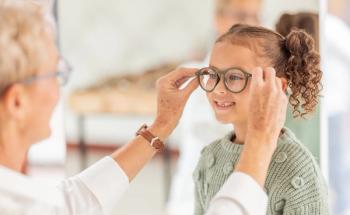
VEW 2024: Dr. Jessilin Quint weighs in on dry eye, uveitis, and contact lenses
Her three presentations, "The Business of Contact Lens," "Blueprint for Success: How to Start a Dry Eye Clinic," and "Unveiling Uveitis" were given at this year's Vision Expo West.
Jessilin Quint, OD, MBA, MS, FAAO, presented some tips and tricks for optometrists to add to their toolbox at Vision Expo West 2024.
Video Transcript:
Editor's note: The below transcript has been lightly edited for clarity.
Jessilin Quint, OD, MBA, MS, FAAO:
Hi, I'm Dr. Jessilin Quint. I'm an optometrist. I coown a practice called Smart Eye Care in Maine. We have 3 primary eye care locations, and I'm here today at Vision Expo as a speaker, and I'm really excited to see all these colleagues.
So on Friday, I have the awesome opportunity to team up with Dr Melissa Barnett and Dr Mile Brujic for a lecture called, "The Business of Contact Lens," where we're diving into everything that can involve contact lenses that can also make your practice profitable. There's kind of this misconception that contact lenses are dead or they're not going to bring in additional revenue, or they're not a great way to maybe build your patient demographic. But we're here to debunk all those myths and really kind of show colleagues how you can embrace contact lens innovation, how you can utilize it, how you can take it to the next level to deliver your patients an awesome experience and make your practice more profitable at the same time. In this lecture, I mean, with Mile and Melissa and myself, we've got a lot of experience about how to make contact lenses really work for your practice. So we're going to be sharing different stories, different things that we've done, hands on things that have worked, that haven't worked, to really just share our knowledge with colleagues and tips and tricks that we found along the way to really help make contact lenses kind of stand out within your practice.
Another really exciting lecture is called, "Blueprint for Success: How to Start a Dry Eye Clinic." And so I'm teaming up with Dr Janelle Davison and Dr Jerry Robin, who are both dry eye gurus, and the 3 of us are really coming together to really provide tips to kind of how you walk through with starting a dry eye practice, right from one patient to then building it up to its own location, or multiple locations. So we're walking through everything about how to do that staff wise, what equipment you need, what you don't need, what's worked for us along the way, and really just kind of provide a blueprint for success. For anybody who is interested in starting their own dry eye clinic.
For patients who are looking to grow dry eye, you have the patients already in your chair. So we know when you're just getting started, it doesn't take a bunch of fancy equipment, you really just need, you, your slit lamp, maybe a little bit of stain, to really kind of start growing that patient base, and then once you start growing that, that is going to turn into to kind of a bigger patient population. But dry eye has had so much innovation, which can sometimes be confusing navigating where all that fits, but that's exciting at the same time, because you have more tools to be able to help your dry eye patients. So being in dry eye getting started, it feels like there's never the perfect time to kind of start anything new. But now is the time, do it. Your patients are there. We're seeing dry eye in a lot of younger individuals. Those patients are going to need care on up to somebody in their 90s, 100s, they're going to have dry eye too. So it's a huge demographic with a lot of innovations, and it's exciting time to get involved in it.
I also have a presentation all about uveitis, or it's called, "Unveiling Uveitis." So uveitis is one of those conditions that's very often linked to systemic things that are happening in the body, and can often present almost like a dry eye if it's chronic or kind of an acute situation. But as a clinician, it's one of those that you are going to see within your chair. So we're going to go over all those different systemic components that can be related to uveitis, how to order lab work. We're going to walk through different case reports, so that we can really leave with a really clear understanding about how we can really treat and manage this uveitis condition. So with uveitis, there's different types. There's parts of inflammation that'll just impact the front part of the eye, the middle part of the eye, or the back part of the eye. A lot of times, especially if it's more of the front part of the eye, optometrists are totally capable of treating that. Obviously, if it progresses to something like a pan uveitis or something evolving more of the posterior pole, then that might, at times, be something that we have to refer to a retina specialist or a uveitis specialist. But a lot of times, an optometrist can really kind of tackle that initially, or at least then diagnose it and make the appropriate referral. But managing uveitis provides a lot of opportunity for optometrists to kind of comanage with different health specialties, but sometimes, even if it's within the anterior segment and it's going to be managed and treated by that optometrist, if it is due to an underlying systemic etiology, then you have to work with that patient's primary care provider, rheumatologist, dermatologist, right? Like several different specialties, which is a really cool opportunity for optometry to be a team player within that. So uveitis, I think, is exciting. It has a lot of opportunity. It's one we can definitely manage, and it's also one you just don't want to miss.
So with uveitis, a lot of times, uveitis can be idiopathic, and that's sometimes a frustrating part of uveitis, but oftentimes it can have a deeper systemic underlying cause. And so when I'm thinking about managing this is if you know an initial presentation of uveitis, if it's just one eye and it's the first time and if it's anterior sag, especially, we just kind of treat that. But if they come back again and it starts to involve the other eye, whether it's now the opposite eye, or if it's bouncing around the 2, or if it seems to be of a more intense severity, or if it's something that even if it's just one eye that they keep having over and over again, then I'm really putting on my detective hat. I'm deep diving a little bit further to figure out, like, what lab tests do we need, what things we need to cross off the list to try to find the root cause of this uveitis condition?
I would say key takeaways for lectures. There's definitely an opportunity for contact lens. So if you haven't kind of revamped your strategy, definitely dive into that. Dry eye has so much innovation, which is an exciting time. A lot of our patients have that need, and it's one that we just definitely don't want to miss as an eye care provider. And then something as simple as, you know, uveitis, right? We learned about it in school. Maybe we've seen a couple of different cases, but it's really helpful to stay up on that education, on that knowledge, learn about the newest developments so that you can continue to provide the best patient care that you can.
I think Vision Expo is really exciting. I think sometimes people think that Vision Expo is just for eyewear or the latest in frames, but this conference offers so much more than that. There is awesome clinical education and a variety of different areas, anything from contact lenses to retina, uveitis, dry eye, ocular emergencies, everything in between. It's a really great way to learn about the newest innovations in every aspect of eye care. So if you haven't ever been to Vision Expo, I would say, definitely check it out. It's definitely worth pursuing.
Newsletter
Want more insights like this? Subscribe to Optometry Times and get clinical pearls and practice tips delivered straight to your inbox.



















































.png)


